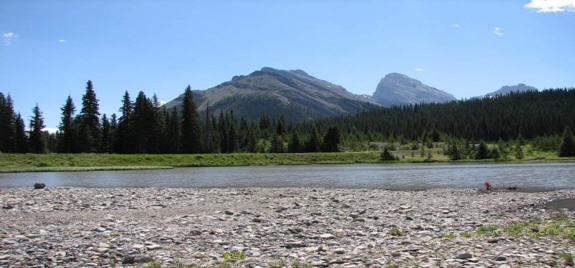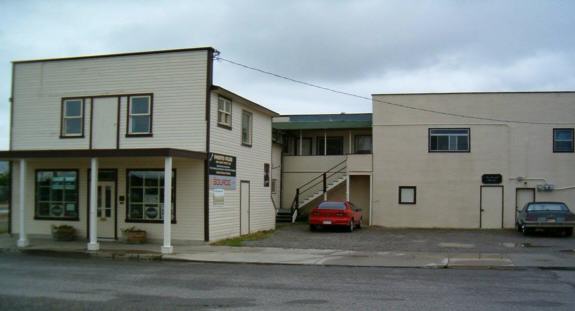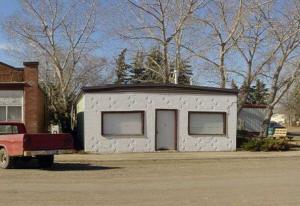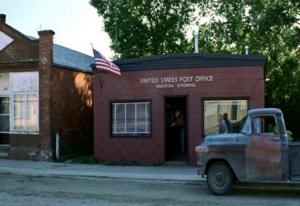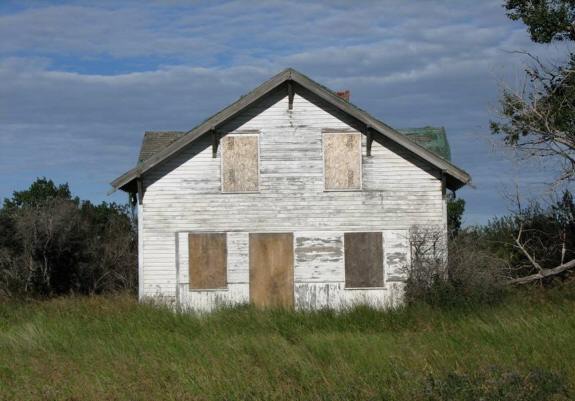|
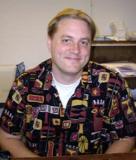 Tell
us something about your early life and how you got into this
industry. Tell
us something about your early life and how you got into this
industry.
Well, I spent my high school years in
Vancouver and then I moved to Edmonton. In my high school we had a
television course where they had VHS cameras and we were allowed to
experiment and make programs. When our family moved to Edmonton
there was an art school there, Victoria Composite, where I got into
theatre and television production and was exposed to a lot more of
the behind-the-scenes process.
From there, I went into technical theatre
school, learning about lighting and set construction and seeing
things evolve from an empty stage to a full blown production. I then
decided to jump into filmmaking and went to SAIT [1] to study film
production. Once that was done, I starved for a year. This is a
fairly difficult business to get into; it is definitely “who you
know.” Cool Runnings was my first show. From there, slowly
but steadily, I kept working and getting to know more people to the
point where I am now a location manager on an Oscar winning film,
it’s cool.
An understatement, no?
There are not many opportunities to, if you
want to use the term, “climb to the top of the mountain” and it’s
inarguable that Ang is one of the top directors on the planet. So I
guess when you get the chance, you really know that this is
something that is going to last forever. When you first read the
script, you sort of look behind yourself to see if I am really in
this position.
You don’t fully grasp the opportunity you have
until you start. Then, as the film takes form, you realize you are
going to be working with a legendary director on a truly great
project. Everyone involved is an icon: that’s who they are, and
they are doing their part. During that time you are only getting six
hours of sleep a night, just trying to get the movie done, but when
it’s all said and done, upon reflection you say, “That was an
incredibly special time.” That’s why you do this, to be part of, to
be given the opportunity to be part of, something great.
I didn’t know Brokeback was going to be
as successful as it was. Of course, it was going to be a good movie,
but I didn’t know how much the greater public would appreciate it.
But I was certain that it would be around for a long time because
Ang has always done remarkable things.
[1] Southern Alberta Institute of Technology,
Calgary, AB.
1

What in your own approach to filmmaking
helped you most in the context of making Brokeback?
Well, I think that when you make movies that
it is very much a team effort. It should be a team-oriented thing.
What can you say about your approach to
finding locations? Do any of the locations in the film have special
importance to you?
I don’t know if you read that Chicago
Tribune article [2] where they came here and they went to
Wyoming. There is a line in that article that is absolutely perfect.
The author first drove to all the small towns and made his snappy
remarks, and then he went to the Kananaskis Lakes.
In that article he says, “Now I know why I am
here.” That’s exactly the reaction that you are supposed to get: you
go there, and you know right away that this is where it is going to
be done. This is it.
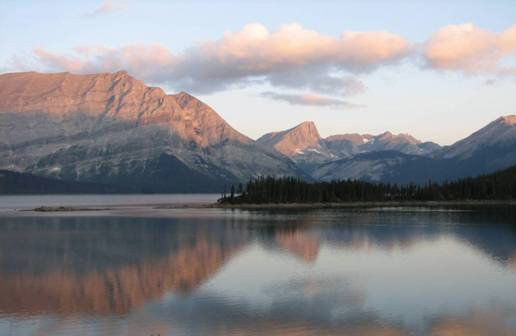
Upper Kananaskis Lake, Peter Lougheed Provincial Park, AB
Another example is the gas station at
Carseland. [3] I saw it on a perfect day under magnificent cumulus
clouds which, as you know, give photos depth. At those moments you
say, “Look at that, this is going to be it.” You know. It’s a good
feeling, of course, that you don’t have to scout for another three
weeks, but more deeply, you know you’ve found a place that your boss
will be happy with. You know. No problem, this is it.
[2] “The lake was rich blue on the big screen
and a spit of timbered land extended into it. It was all white now,
except for the timber, but even though it wasn’t like this when I’d
seen it onscreen, I knew exactly where I was. And, for the first
time, why I was here.” Alan Solomon, “Going for Brokeback,”
Chicago Tribune 23 Apr. 2006.
[3] This scene was cut.
2

A lot of sites in the Kananaskis
area I knew would work right away but there are always political
things that happen. You have to bring both an emotional and a
logical approach to every place you find. There are some locations
that we scouted that are amazing, but you just can’t get there.
Frustrating?
Oh yeah, we went right to the
Rocky [Continental] Divide. There was absolutely no way we could get
a) permission and b) equipment and crews there for the amount of
money that we’d been given. That was not going to make our movie.
But we wound up with Moose
Mountain, which is relatively close to Calgary. The other place that
we would have considered was actually near Cowley on the east side
of the Livingston Range. In the story, Brokeback Mountain appears to
have two steps to get to the peak but everywhere we found had only
one step. The problem we had with Livingston Range was that although
it is high, the base is high as well. From 3,500’ to 8,000’ is not
enough distance for you to believe that it took them all that time
to get from there to here. But on Moose Mountain it looks like
you’re on the moon. You’re up so high you know you are above the
tree line and that’s important. The whole point of getting sheep
above the tree line is that because sheep can eat anything, so it’s
more efficient to put the sheep up there and leave the cows lower
down where there is more grass, allowing for more animals and
yielding better returns in the fall. And when you get up there on
Moose you can buy that. Once you get up that high, you realize,
“Okay, it all makes sense.”
We also had difficulties
obtaining permission to use sites from Provincial entities. Did you
read that Swerve [4] magazine article? That process took a whole lot
of working through.
When we first started looking at
Fortress Mountain and the Livingston Range in January, the
authorities suggested that we look at Moose Mountain and the flats
to the north of there and because the sheep carry a bacteria that
can wipe out wild cloven hoof livestock. Everywhere we scouted we
were frustrated. Fortress Mountain, the Livingston Range, a mountain
in the southwest, way, way near the [U.S.] border that we looked at,
those just didn’t work out. One of them had already had an epidemic
that had wiped out a lot of bighorn sheep five years ago because one
domestic animal got out and wandered off. In the case of the
Livingston Range, we were too close to ranchers so we thought “It’s
a hornet’s nest.” That is how we ended up with Moose Mountain.
[4] Jacquie Moore, “The Real
Brokeback Mountain,” Swerve Calgary Herald, 3 Mar. 2006:
18-28. The article explains that domestic sheep carry a bacterium
that could infect and jeopardize the wild sheep population of the
region. A lengthy negotiation involving biologists, the filmmakers,
and Provincial authorities was required to secure permission to use
certain sites.
3


Moose Mountain
Moose is higher than some of the
other ranges we had been to. It still had two feet of snow when we
started in January and since no one had been crazy enough to try to
drive the goat track up there, we had no idea what it was going to
look like when it was time to shoot. We were shooting for three
weeks before we actually got to see what Moose Mountain looked like
under that snow and to make sure that it was green. We had no idea.
Our reactions to the
film teach us things about ourselves. We would be honored if you
would share with us some of your own reactions to the story.
This was the best script I had
ever read. First, I obviously was into it already because I knew who
was involved in the production. But there were a couple of moments
when reading it I knew this was going to be agonizing, emotionally
overwhelming.
Overwhelming?
Yes, you know for me, it was the
“I Wish I Knew How to Quit You” scene, which on the printed page was
horrible; it was just gut wrenching. Having to read that and know,
oh so frustrating to be able to care for someone that much and not
be able to control yourself.
Then at the end of the film, what
really got me was Ennis’ chat with his daughter because in that
scene he gives his advice. As he did it, from the way [Heath Ledger]
gave the line, I don’t think that he realized that he’d given the
absolute opposite advice of what he himself did. “Do you love him?
Well then, you should be with him.” Totally not what he did in his
own life. He loved Jack; he should have been with Jack.
I think that on some level, Ennis
is a character all about regret. It is amazing; regret is a theme in
a lot of Ang’s movies where true love is postponed for something
more important. And the character always regrets it. Falls
because of it. If you look at The Ice Storm, a couple
passes over true love trying to get by in the suburban jungle. They
could be happy but instead they opt for the politics of the suburban
jungle. And in Crouching, Tiger Hidden Dragon, the lead
swordsman passes on true love for duty. Here, Ennis passes over true
love for the judgment of other people, out of fear. It is a theme
throughout Ang’s movies. When you read it for the first time, you
can see it. It’s there. It’s jumping out at you. You’re enjoying
reading it, but you are also feeling so bad.
4

The script had a
“made-for-Ang Lee” quality?
As you know, that script had been
around for a long time. For the longest time this was the “best
screenplay that could never be made.” They didn’t think that anyone
could tell the story in the manner that Joe Six-pack would be able
to appreciate. Then Ang saw it, loved it, and knew that he could do
it.
Ang Lee is the rare director that
can make a film others deem impossible. First of all, movies like
this are made to win awards – not to make $175 million. So you know
that if you are making this for awards you’ve got to have someone
heading this project who will draw acting talent. You don’t
necessarily have to find them, they will come to you.
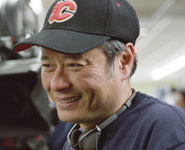 Actors
really want to work with Ang because he is a magnificent person. Not
at all dictatorial…he’s just fantastic. So they are attracted to the
project and when that happens, it’s a ball that just keeps rolling.
Now everyone will do what it takes, not to make Ang’s movie or to
act out of fear; you do this one out of pride and desire to make
this film for the greater good. That’s his true genius, getting
people to contribute to the project emotionally, as well as simply
doing their jobs. Actors
really want to work with Ang because he is a magnificent person. Not
at all dictatorial…he’s just fantastic. So they are attracted to the
project and when that happens, it’s a ball that just keeps rolling.
Now everyone will do what it takes, not to make Ang’s movie or to
act out of fear; you do this one out of pride and desire to make
this film for the greater good. That’s his true genius, getting
people to contribute to the project emotionally, as well as simply
doing their jobs.
He has that keen eye and an
observer’s mentality. In fact, he really does not say very much.
He’s very, very quiet. As such, when you do get something out of
him, it’s always a treat. You find that his favorite restaurant is
Dairy Queen because when he got off the plane from Taiwan, that was
the first restaurant as he was leaving the airport and he went in
there. It became his emotional connection to his new life in
America.
I tell that story because it says
something about him. Dairy Queen, whatever, is a big deal for him.
If you think about it in the big picture, it symbolizes his new
life. So, he treasures things like the bus station. When we walked
in the bus station, we knew this was going to be our diner. Where
we’d encounter potential problems, Ang’s reaction was, “Don’t worry
about it, this is going to be it; it’s perfect. We are going to do
some stuff [set dressing] here and there but this is going to be
it.” He walked around, loved the whole thing-the cafeteria line,
everything is stainless steel-you know, fantastic.
Another thing, he likes is to
take his time. There is no rush; there is no panic. We’d show him
all these places but he wouldn’t commit to anything until the next
day. He’d sleep on it. I’m used to working with the “General” type
of director who walks in and makes a decision on the spot. Ang is
not like that at all. For instance, take the bus station; everybody
knew that was it, perfect, right? But we learned not to say
anything, even though everyone was bouncing off the walls with
enthusiasm inside; nobody said anything. We waited until the next
day when Ang said it was going to work. Then we knew everything was
going to be okay.
5

Were the choices he
finally made close to the ones you had anticipated?
Well, there were a few locations
that were kind of different from where I thought we were going to
go. I think a lot of that had to do with a tour they made of Wyoming
during prep so they could get an idea of what things look like
there. There are cultural things that are different between Wyoming
and Alberta, which is odd because Alberta was largely populated by
Americans emigrating north from Montana.
In most of the bars located in
smaller Alberta towns the bar setup is oriented around beer as
opposed to Wyoming where it is about liquor. Our bars, I am sure you
have been to them all, typically have a cooler [refrigerated display
cabinet] behind the bar; the focus is not on the bar. In
Wyoming, the culture of the bar is about the bar
and commiserating with your bartender. The bars they saw in Wyoming
were simply the bar and two pool tables; that’s it. There
was no real table-and-chairs setup. In southern Alberta, it’s all
about the tables and chairs. So we had to figure out how to make
that work. All of the bars we could find were way too small, way too
small and we did not have the money to make this monster bar that
everybody felt we needed.
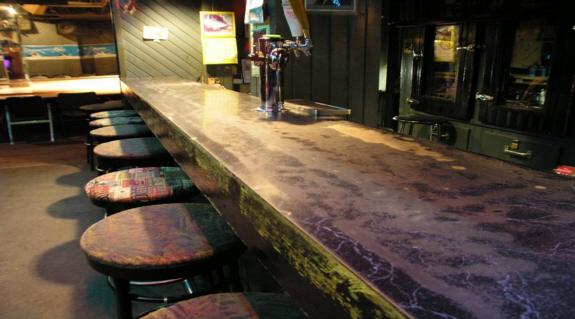
Electra (Clown) Bar, King Edward Hotel, Calgary, AB
It became sort of a mad adventure
where we kept digging. The definition of insanity is where you
repeat the same action, again and again and again, expecting a
different reaction that never happens. “Okay, let’s keep looking for
bars,” “No, they all look exactly the same, the tables, the cooler,”
“Okay, then I got an idea; let’s keep looking!” “No, they all look
exactly the same, the tables, the cooler,” “Okay, let’s keep
looking.” (laughter). We went out, and we went out, and we went out
and still nothing. It was unbelievably frustrating. Eventually we
had to pull the brake, someone had to pull the brake, and we had to
give up and figure out something else.
When you are making a movie on a
smaller budget you need to group things together. The way you guys
did your maps on the website [see: www.FindingBrokeback.com,
“Geographic Locations”] is exactly the way we had our pre-production
meeting.
6

[Executive Producer] Michael
Hausman showed us a map of Alberta and said, “Guys, we are going to
find everything in these three places.” He puts a tack on Canmore;
he puts a tack on Fort Macleod, and then points to Calgary. “That’s
it; we’re not going anywhere else.” We had to house people at Fort
Macleod, and we had to find everything there. We had to find
everything in Canmore, and we had to house everybody there. And
Calgary, everything had to be a drive from Calgary which is why that
square is bigger; you are able to drive out to some of those places.
By doing that, he enabled Ang to
make a better movie because instead of spending money on hotel
rooms, we spent it on cranes and film. It allowed him additional
time to make better shots and more time with the actors. I think
that is what Michael and then Ang needed. This was a drama. In
drama, you need time to make performances work.
The choice of Moose Mountain,
with its proximity to Calgary and accessibility, gave Ang so much
time everywhere else because he was able to get that hour of
overtime in order to make sure that he got those extra two shots for
a scene, to make it just right; that extra hour with the actors to
make sure that the sun dropped just a little bit more; that extra
day or two of Second Unit so we could have truck shots.
For instance, the opening shot.
The amount of time it took for us to get that shot organized would
boggle your mind. We filmed it in late July or early August; it was
near the end [of shooting]. We were trying to schedule it earlier,
but the problem was that we were again trying to find the perfect
road, even though that was the first place we thought of. We needed
a north-south road so we could look east-west and see the sunset,
pretending it is sunrise, and it will look fantastic shot from up
high: the little, tiny truck so you could put credits here
(gestures) in the negative space. I am trying to remember if they
did credits or not, I don’t think they even bothered; it was too
perfect, right? But that is the sort of thing you take [still]
pictures of. The reason that our pan [panoramic] photo of that shot
is not in there (gestures to a book of production photos) is that it
is so big. We did that to show that you could hold that shot for a
really, really long time to establish both where you are and how
small they are in the whole grand scheme of things.
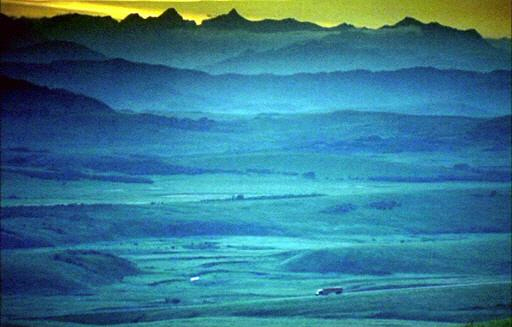
Hwy 22, south of Longview, AB
7

Once they decide “Okay, this is
going to be the place; it will work,” then you have got to get
permission from the government to control the highway so we don’t
have any bogeys in the shot and that was (inaudible). That is why I
whispered it to you so you wouldn’t get it on tape. Then the other
thing we needed to do was to get one of our guys out there to do
what we call a photo test. Say the sun is going to set at nine
o’clock, we get to the camera location at seven with a battery
operated clock and take the picture looking toward the mountains at
7:00, 7:15, 7:30, etc. and keep going until it is black. That helps
the DP [Director of Photography] to decide when he wants to shoot
this. Once we knew that he wanted to shoot during a particular
period, we had to make sure that we had all the vehicles and that
the parking was going to work. We talked to the neighbors so they
knew what was going on…all three of them! (laughter)
Little things like that just take
forever for some reason, and sometimes major challenges prove to be
quite easy. When I read the script for the first time, I thought,
“How in the world are we going to find a supermarket that we can
afford to be in so she [the Set Designer] can dress it to look
period?” Supermarkets nowadays, they ring in $100,000 a day. How in
the world are we going to get that? And within two days we had found
two! One supermarket in Beiseker that was closed down, had all the
shelf space, all the old registers, the old, if you remember way
back when they had the spinners, instead of the belts, and wow! And
then we went to Crossfield and they still had all the stock! When I
got there it was two weeks before the closing and the move to their
new store. I thought that was going to be the nightmare of the show,
finding this supermarket and being able to afford it, and two of
them fell right into our lap absolutely perfectly. Meanwhile, the
scenes where you go “No problem, no problem, we’ll be able to do
this,” those are the ones that take forever! That is a lot like
life. Some things, some opportunities fall right in your lap; some
you’ve got to work for, and they are rarely the ones you think of,
you know.
In your answer, you
made the transition from the mountain locations to the flatlands.
When we talk about the flatland locations, we often use the word
“gritty.”
Yes, what we found very early,
like in the first three days of our scouting, is to avoid the
highways. It made a lot of sense given that the way that rural North
America was built was first with agriculture and when you had
agriculture, then you had railroads. We wound up focusing on rail
towns, off the highway, because all of these rail towns basically
have been “on pause” for development since World War II, which is
roughly when the rail stopped being a primary source of
transportation. After the war, the defense factories needed to make
something else. So instead of building tanks, they produced cars.
Then highways started getting built. The towns that were on the
highways have moved on, but the towns that do not have highways, for
example Blackie [5], have not changed since the ’40s. They have not
changed. Cowley [6] has not changed. Fort Macleod, even though some
might argue that is on the highway since it is on [secondary]
Highway 3, I would say since it is not on the [major] Highway 2
corridor, it has not changed.
[5] Thanksgiving Fight Bar.
[6] Signal Streets, Aguirre
Trailer.
8

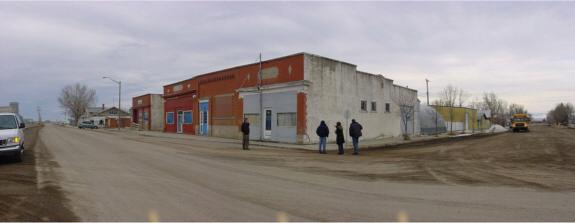
Blackie, AB
Our alternative to Fort Macleod,
Lacombe (railroad, off the highway) is exactly the way that it has
been since the ’50s. Lacombe still has the awnings over every
building; it is mind-boggling. Lacombe did not work because there is
nothing else around it. Fort Macleod had Claresholm [7], it had
Cowley, and we were able to find things around it. That is how we
searched; we took a map of Alberta and highlighted every rail line,
current and former. These were the areas where we scouted, and that
approach paid off. We found all the period stuff we needed….boom,
boom, boom; it was so much easier then. We had tons of stuff that is
not in there (gestures to volumes of pre-production photos). The
stuff we did not use would be three times higher!
It really shows how smart Ang is.
In his head, he was able to make Fort Macleod, parts of Cowley,
parts of Carseland, Blackie, Crossfield, Rockyford, and Calgary all
one town. As we did this we all were trying to figure out how it
would look when it all came together. Well, it does work.
In Rockyford, a block down [from
the Childress Dance Hall exterior, Riverton Post Office, JT’s Bar,
and phone booth locations], there was a period gas station right
there. We could have used that. We could have saved a gazillion by
shooting there instead of going to Carseland, but the gas station in
Carseland [8] was too perfect. That was the hill to die on
. It’s fantastic. Those are the ones where you say, “It’s worth it
to come here for this” and there were compromises for a lot of other
places which we knew were too far to go, like that Texas gas station
[9]. It looked great, but it was too far to go.
On the other hand, we still felt
it was worth it driving out to Dorothy [10]. It was a long way, but
it looks great. I asked, “What would you like, Ang?” He told me “I
would like it very dusty.” Okay, that’s no problem; we just went out
and scouted everything that was within two miles of Dorothy.
[7] Divorce Meeting Cabin and
Lonesome Ranch.
[8] This scene was cut.
[9] This scene was cut.
[10] Ennis’ Flashback.
9

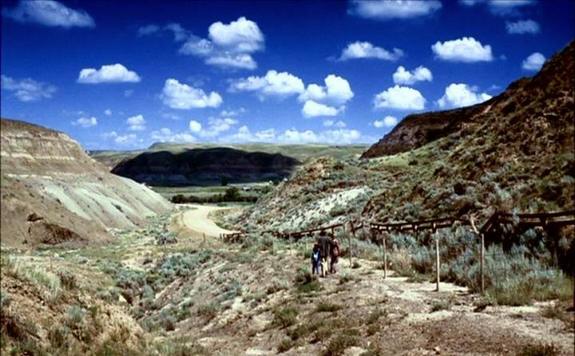
Dorothy, AB
Describe your first
meeting with Ang Lee.
Um, at the Palliser Hotel
[Calgary], and it was quite funny. I was worried that this was a
big-time Hollywood director: very demanding, very I am the star
of this show. Our production manager Tom [Benz], told me,
“Don’t worry Darryl; you would not spot him in a line-up, so
unassuming, so unlike the stereotype. Everything is going to be
fine.” When he came up to his room, he was just a regular person. I
knew they were in the elevator, and I knew it was our floor. And I
knew that it was him coming out, but I still looked in the elevator
(laughter) to see if there was somebody else in there! Where is this
big-time director? Where is he?
Reserved?
Yes, a very big thing in their
culture. I would not say shy, I think reserved. I almost want to say
shy because there were some times when he did not want to meet
everybody, though he does like meeting people. I’ll say reserved.
Then there was the producer
[Executive Producer Michael Hausman], what a contrast. You could
tell the leadership just bounced off of him, right, “Hey, you guys
allow New Yorkers [expertly accented] in here?” That was his big
line to break the ice in all of the smaller communities and right
there, they thought, “You are okay.” “Yea, we’re not from here;
we’re from out of town. Just get that over with; I know, you know,
okay.” And it was.
10
 |
 Tell
us something about your early life and how you got into this
industry.
Tell
us something about your early life and how you got into this
industry.


 Actors
really want to work with Ang because he is a magnificent person. Not
at all dictatorial…he’s just fantastic. So they are attracted to the
project and when that happens, it’s a ball that just keeps rolling.
Now everyone will do what it takes, not to make Ang’s movie or to
act out of fear; you do this one out of pride and desire to make
this film for the greater good. That’s his true genius, getting
people to contribute to the project emotionally, as well as simply
doing their jobs.
Actors
really want to work with Ang because he is a magnificent person. Not
at all dictatorial…he’s just fantastic. So they are attracted to the
project and when that happens, it’s a ball that just keeps rolling.
Now everyone will do what it takes, not to make Ang’s movie or to
act out of fear; you do this one out of pride and desire to make
this film for the greater good. That’s his true genius, getting
people to contribute to the project emotionally, as well as simply
doing their jobs.




